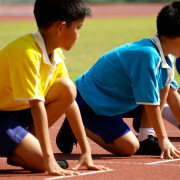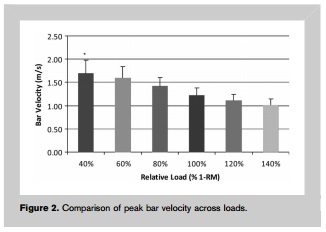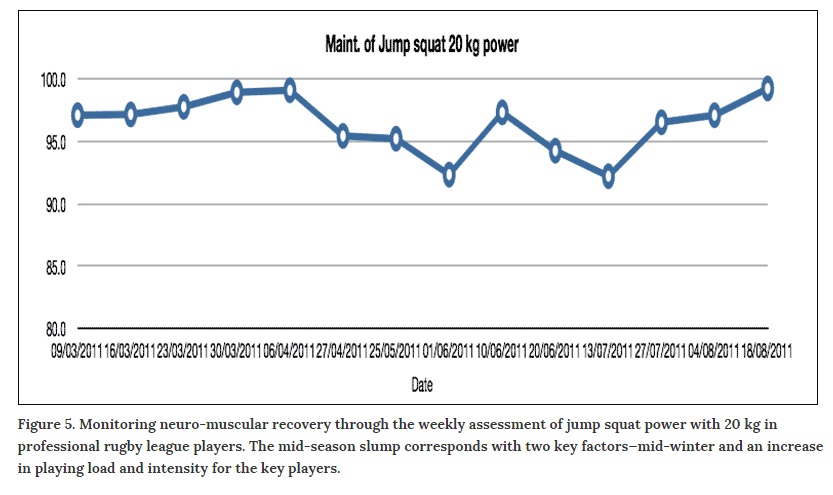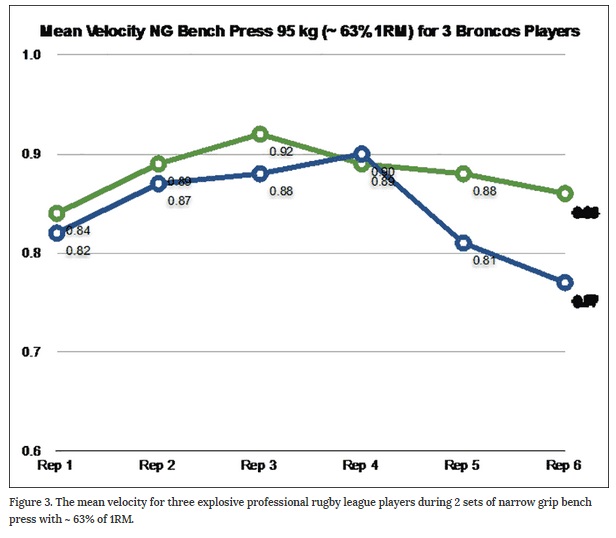How much should junior athletes train?
/in APA Blog /by hloftI recently received a nice email from one of the coaches I taught on the 1st4sport Level 2 Certificate in Strength & Conditioning so I thought I would answer it as a blog post. His questions are all about programming for junior athletes.

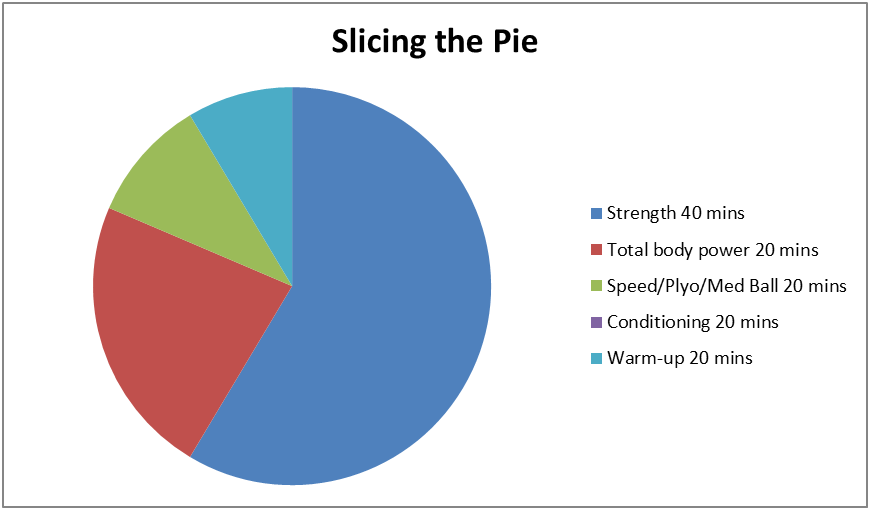

What does the research say?
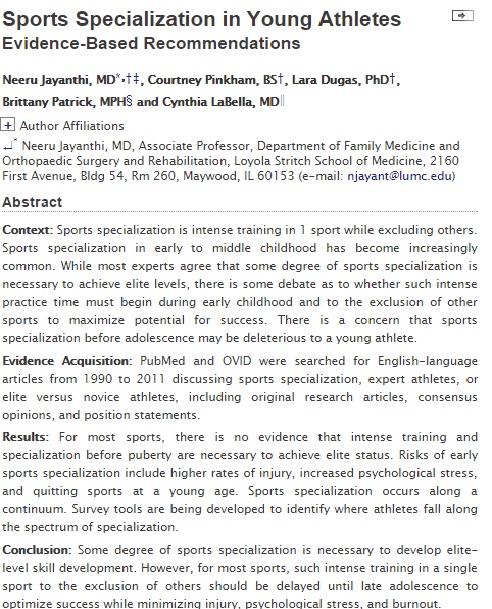

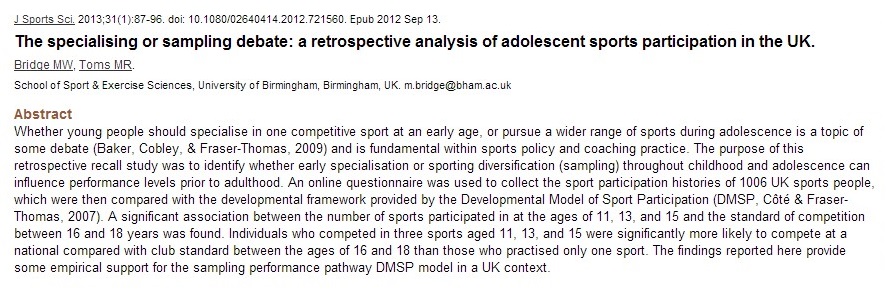
This research confirms for us a couple of principles of training for young athletes
The problem of some tennis parents (and coaches) is that they have never read any Sports Science recommendations. My personal opinion is if a junior tennis player has talent, then 15 hours a week tennis training + fitness and tournaments is more than enough for his/her development. If a tennis player does not have enough talent to play on the pro level, why destroy the young athlete’s health with 30 hours of training a week?
What about the multi-sport athlete?
I am all for playing several sports but there does reach a point when an athlete who truly wants to excel in one sport needs to start to specialise. The 12-16 year old age range I previously spoke about is where I feel the balance needs to start to shift towards one main sport- training as much as 85% in that sport. So I would need to ascertain from the coach what age group of athletes he is coaching; if the girls are 8-11 years old (pre-puberty for argument sake) then being a multi-sport athlete strikes me as a good thing.
Regarding the coach’s questions 2 and 3 it seems like the girls are not playing all three sports at the same time. The sport changes with the time of year. For the recreational athlete, or even a sport scholar, I think this is a good thing in principle- provided they are a bit younger. If they are older and truly want to excel at one sport though, I wouldn’t be chopping and changing sports throughout the year.
As the coach says, the main downside of being involved in several sports however, is the potential to be able to practice all year round! You never get to switch off and you could burn out!

Normally you would expect the athlete to go through a periodised plan which includes work, rest and play!!! In an ideal scenario you would work hard in your training phase, then go out and compete and then have a rest. Most professional sports calendars have an off-season where athletes can spend a few weeks re-charging their batteries before they hit their training again.
Should juniors get ready for their sport by training in the summer holidays?
Using mean bar velocity to predict 1RM
/in APA Blog /by hloftIf you read my post last week you will notice I am going to start measuring the Reactive Strength Index (RSI) during a 30cm drop jump as part of the weekly monitoring with APA athletes. I believe it will be more sensitive than using a standing vertical jump for this specific purpose.
I have also been looking at the use of the Gym Aware linear transducer for monitoring bar speed and the different applications for training. The inspiration for this blog is based on sections I have been reading in a round table discussion- Freelap USA Round table: Velocity based training: for the Full article click HERE
I have summarised some key points below which I hope will help you decide on whether measuring bar speed is for you:
BRYAN MANN:
Training: % 1RM vs Bar Velocity:
If you asked what % of 1RM should you be training at to develop strength-speed, people would tell you around 50-65% or maybe even 70%. But if you tell them a velocity range they look at you like you’re crazy.
If we know we want to develop strength speed, we are looking at 0.75-1.0m/s (40-65ish% of 1RM); for accelerative strength 0.5-0.75m/s (around 65 to 80ish% 1RM); for absolute strength, under 0.5m/s (85-100%). Simply using velocities that correspond to the % of 1RM desired allows you to be right on the load you are utilizing, rather than hoping to be lucky that it was correct on any given day.
MLADEN JOVANOVIĆ:
1-RM Squat Prediction
Long story short, one needs to know each lifter’s MVT (or minimal velocity threshold, a fancier term than velocity at 1RM) for every lift (or use generalized velocities—they can be pretty stable across different lifting abilities). Bench press tends to be 0.15 m/s (mean velocity) and squat around 0.3 m/s (mean velocity). One can then proceed by performing at least 3 warm-up sets with increasing weights (hopefully covering a range of at least 0.5 m/s) performed with maximal effort. Using simple linear regression, one can estimate weight at MVT. This can be 40%, 60% and 80% or 1RM. This can give one a quick estimation of 1RM (i.e. daily 1RM) that could be tracked over the duration of the training block and used to make adjustments if needed, or to basically see how the athlete is reacting to the training (if the goal is to increase 1RM).
Having heard what Mladen had to say above I decided to do an experiment of my own having read a few of his articles on hiscomplimentary training website.
Example: Pro Tennis player
Here is the example of a predicted 1RM test for a pro Tennis player I work with. It’s not the best example and I’ll explain why but it gives you an example of the protocol.
The issue we had with my experiment was that we were ‘in-season’ and doing this between two important tournaments. We hadn’t done a 1-RM recently and given he hadn’t been in a training block for a while we conservatively estimated his current 1-RM at 160kg. This was because his previous pre-season 1-RM was 180kg. Therefore we calculated his 3 warm-up sets with increasing weights (as suggested by Mladen) as 55, 65, 75 and 85% of 160kg. The better solution is to have a more recent 1-RM to base your warm-up sets on. But as we only had a few days training I didn’t want to risk overloading him so I just guessed he would be around 160kg.
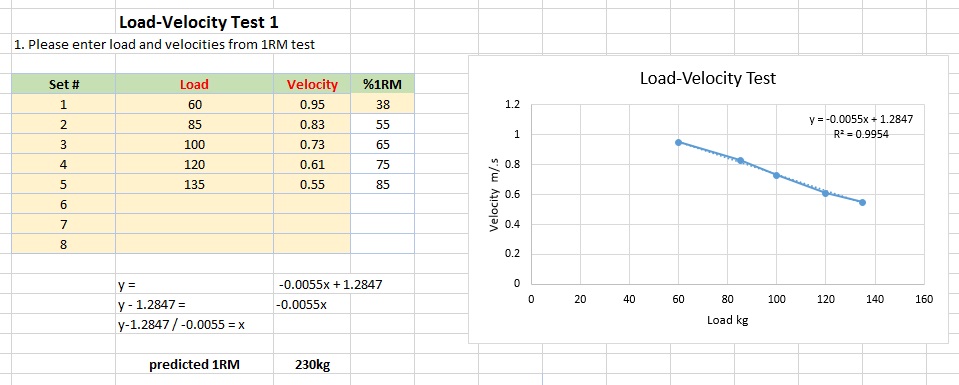
For those of you like me who are not mathematically minded I have rearranged the linear regression equation you can get in excel. If you know the value of Y (0.3 m/s) which is the bar speed at 1-RM you can insert this value into the equation:
0.3- 1.2847 / -0.0055 = 179kg
As you can see I was able to predict that the athlete’s 1-RM was 179kg. I was therefore able to track his 1-RM without actually having to get him to do it!!!!
One thing I would say is to make this assessment valid and reliable Mladen recommended doing 3 reps at each of the warm-up set loads. He also recommended holding the position at the bottom of the squat for 1-second before lifting back up. This may need some practice to orientate the athletes with this especially at the lower loads where the temptation is to move the bar much faster.
1-RM Power Clean Prediction Example
I have also wrote a blog previously about the application of using the clean pull to predict the 1-RM for a Power Clean. J Strength Cond Res 26(5): 1208–1214, 2012. For the full blog post click HERE
Findings:
- peak power occurred in mid thigh clean pull at a load of 40% 1RM of Power clean
- this corresponds to a bar velocity of 1.65 m/s
What I found interesting was that the bar velocity which corresponded to 1RM for the power clean was 1.25 m/s so you could load up the clean pull until you get to 1/25m/s and this would give you an idea of their power clean load.
The final section below discusses some further considerations when selecting exercises that are appropriate for training and testing power.
DAN BAKER:
Difference between a Strength exercise and a Power exercise:
Despite the same sort of % 1RM (sets working from about 70 to 80% 1RM), the mean velocities are much different. For the snatch push press, the velocities are around 0.8 to over 1 m/s. For the heavy squats, 0.3 to 0 .5 m/s. For the snatch push presses, the velocities remain fairly stable, despite the increase in resistance for each set. For the squat there is a decrease in velocity with increased resistance.
Strength exercises have a deceleration phase at the end of range when resistances are low (< 50% 1RM)= to avoid stressing the tendons and joints. On major strength exercises like squats, bench presses, and deadlifts, with resistances below 50% 1RM, more than half the ROM is spent in deceleration, making them less than ideal for power training even though at this low level of resistance the velocity may be high. The length of the deceleration phase decreases as resistances go above 65% 1RM. By 85-90%, there is no real deceleration phase, but the velocities are so low at this level of resistance that they cannot be classified as power exercises. So using light resistances below 50% 1RM in traditional strength exercises to develop power is often counterproductive as it is training the body to decelerate for much of the ROM, rather than continuing to accelerate.
So we do strength exercises with heavy resistances to develop force/strength, and power exercises with the appropriate resistance to train the body to use force with high velocity until the end of range. If you want to use “strength exercises” to develop power, you need to use resistances of 50-70% 1RM. Something to dampen the ferocity of a rapid lockout (such as bands and chains) also helps.
In addition, there are two measures of velocity and power—the mean or average of the entire range of (concentric) movement, and the peak, which represents the highest velocity in the shortest measuring time (say 5 millisecs). So there will be a difference between the two measures. When someone is doing a lot of end-range deceleration (because they may be trying to lift 30-40% 1RM in a bench press explosively), there will be a marked difference between the two figures as the body has to severely decelerate the lock-out to protect the joints. In Olympic lifts, which are virtually full ROM power exercises, there should not be a huge difference. If there is a more marked difference for one athlete compared to others, it suggests that they are decelerating near the end of ROM.
Why would they? Because they have mobility or technique problems and the body inherently knows not to continue accelerating (or at least, lifting with high velocity) until catch or lock-out. It may be dangerous to the involved joints, tendons, etc. So there may be a high peak velocity, but the body will slow down the speed to avoid dealing with high force and high velocity at a vulnerable end of ROM in athletes with mobility/injury concerns.
This may suggest that you don’t perform the full versions of the Olympic lifts (or power versions) with athletes who have mobility problems. You may be better off performing a variation (for example, clean power shrug jump instead of power/hang clean).
More than 20 years ago, Greg Wilson called this point—where mean power is highest—the “optimal power load.” It is different for every exercise and there is also individual variation. Some of my published research looks at bench press throws in a Smith machine by professional rugby league players. That “optimal power” (mean power of the entire concentric range) was 55% 1RM for weaker blokes (about 125 kg 1RM), 50% 1RM for the across- the-board normal blokes (about 140 kg 1RM), and 45% 1RM for the strongest blokes (about 150 kg+ 1RM).
Counter movement jump or Depth Jump- which is better?
/in APA Blog /by hloftFor as long as I can remember I have used the standing vertical jump (SVJ) with an arm swing and a squat jump without an arm swing to measure power. I use the SVJ as a measure of performance first and as a measure of fatigue second.
However, I have always doubted the usefulness of the vertical jump score as a measure of physical preparedness from the point of view of neural fatigue. I have reconsidered some research and also found some new information. Below is some of my research.
The first part is based on experimental research conducted by Dave Hamilton, who presented his work with the Great Britain women’s hockey team in the three years of preparation for London 2012, at the UKSCA Conference.
The second part are some snippets of interviews that were conducted by Freelap USA during a round table on ‘Velocity Based training.’
Before we get into the findings it will be useful to clarify a few terms. For ease of understanding I will clarify the difference between a depth jump and a drop jump.
Depth jump vs. Drop Jump
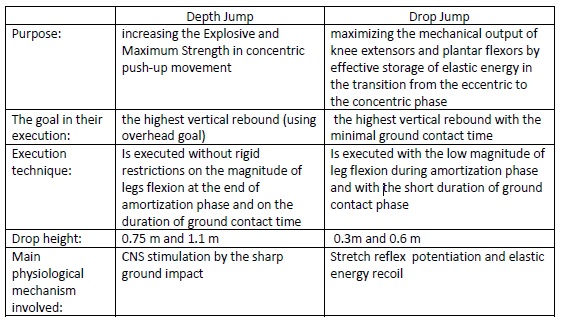
In the use of Drop Jumps, there are some problematic issues. The first issue regards the danger of Drop Jump for the leg joints, especially if performed from a high drop height. In fact, the important condition for efficient recoil of the elastic energy is the muscle’s stiffness during the amortization phase. In order to assure this condition, Drop Jump should be performed with low level of leg flexion at the end of ground contact phase. However, if the athlete “drives as a stake” into the ground, with the straight legs, the ground impact is too hard for his leg joints. This opinion has been confirmed by many researchers (for example, by B.U. Newton, W.B. Young, W.J. Kraemer and C. Byrne, 2001)
To avoid the danger of sharp heel impact, it has been suggested to use Drop Jumps only with low drop heights of 20–40 cm (Bobbert et al., 1987; Lees & Fahmi, 1994). The problem is that the use of 30cm drop height is ineffective at increasing the rebound height: it could assure only decreasing ground contact duration (W.Taube et al., 2011).
Taken from Jump Training 101- Dr Natalia Verkhoshansky
I’ve selected the video below to stress the fact that there needs to be a certain level of athleticism required to safely execute a drop jump. The high levels of eccentric loading could cause significant stress to the knee joint if not adequately prepared. Note the knee valgus present.
Part 1:
Dave Hamilton-Drop jumps- Reactive Strength Index (RSI)- DJ-RSI
Dave spent the first year of his role understanding the demands of the full-time hockey programme. In his second year he focused on Monitoring:
His previous research with soccer players had shown that the counter movement jump (same as SVJ but without use of arm swing) didn’t show promise as a sensitive indicator of neural fatigue as indicated in the figure below.
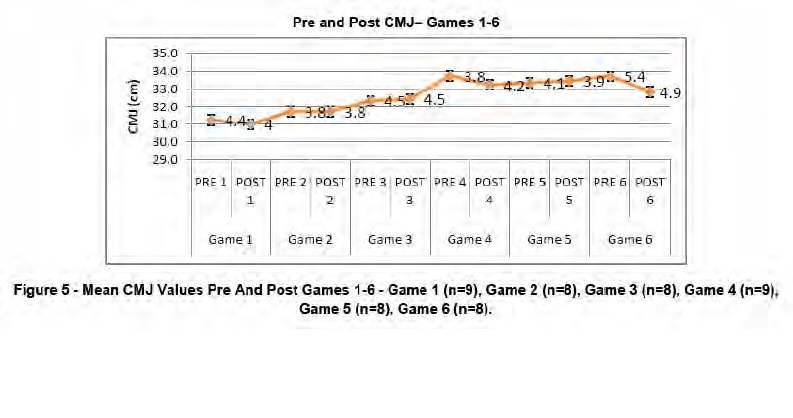
Performance in the CMJ actually increased across six games. Several other researchers have supported this.

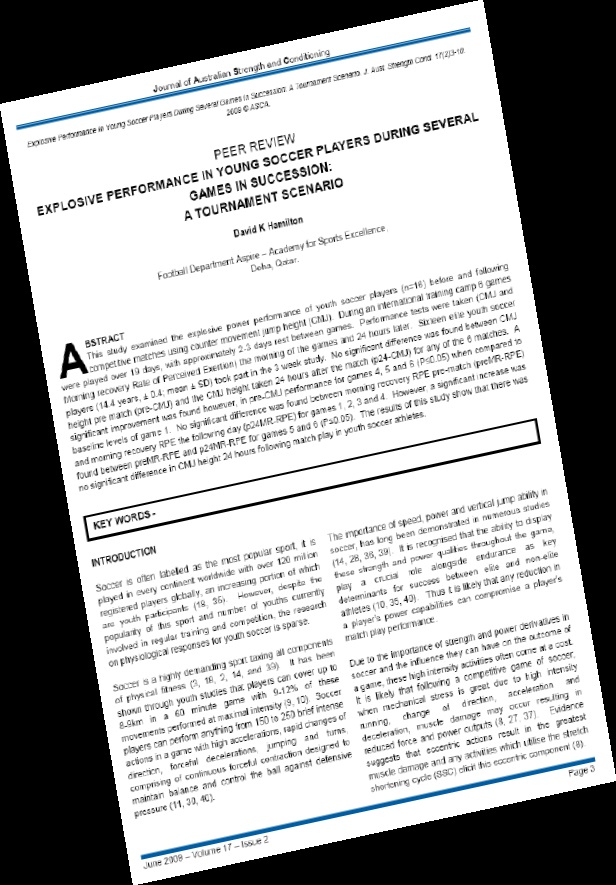
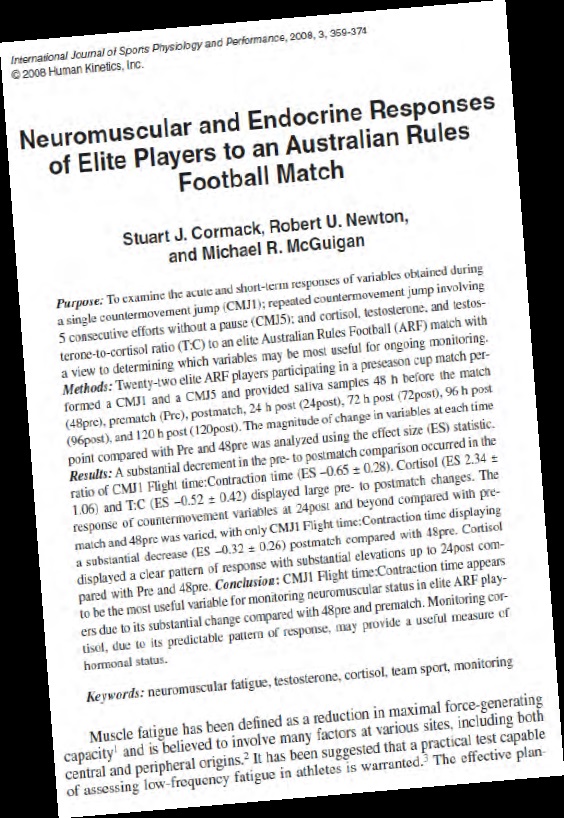
Use of the Drop jump with calculation the RSI showed more promise because as the Figure below highlights, his research showed there was a significant drop off between pre- and post-game scores.
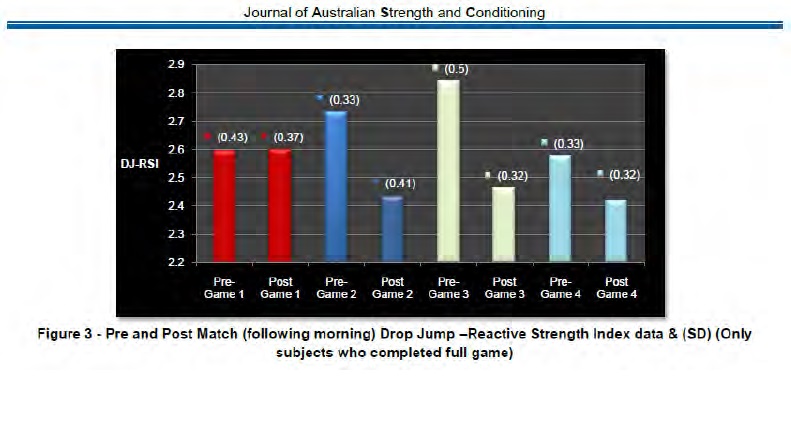
My conclusion: I have concluded that a drop jump from 30cm will be a more sensitive marker of neural fatigue than a standing vertical jump
Part 2:
Freelap USA Round table: Velocity based training: for the Full article click HERE
Bryan Mann:
While the vertical jump used to be the gold standard for monitoring, it really isn’t any longer as it isn’t sensitive enough. Many things can confound the results. Using technology, we can look at multiple factors that go into the jump.
A podcast with Carl Valle—who is also on this roundtable—mentioned using 40kg as the load for the jumps. You are getting weekly longitudinal data and a small training effect. Squat jumps are ballistic in nature and thus have a very minor deceleration phase—if one exists at all. But what’s wrong with getting some ballistics in every week? Nothing. It is going to help improve the athlete’s RFD.
Whatever type of jump you do (countermovement or non-countermovement), be consistent. Do it on the same day or same phase of the week
Mladen Jovanovic:
To use jump training for estimating “readiness” or NMF (neuromuscular fatigue), one needs more sensitive tools and methods. Simple jump height will not do it because one can have high NMF and still perform countermovement jumps (CMJ) to the same height. What changes is the way that height is achieved, or the “process” behind the jump. Height is just an outcome. Please note that I am talking about estimating readiness and NMF is not a performance indicator.
I would also tend to agree that the more “reactive” the jump, the more it might tell you about NMF. Using 20kg CMJ might not be sensitive enough to estimate NMF since athletes can “grind” it through.
Modify the Long term approach
Speaking of using jump testing—or any other “readiness” estimate to individualize training—it shouldn’t happen acutely. In other words, we are looking for trends and creating a longer-term “prescriptive model” for an athlete based on reaction trends, rather than jumping on “red flags” to adjust daily workouts. So what if your HRV is lower by 10 than yesterday, or your jump power is lower by 5%? We need to rule out normal biological/measurement variability
Dan Baker:
When I worked with Olympic divers, we did squat jumps (no countermovement or arm swing), countermovement jumps (no arm swing), and a vertical jump with arm swing that mimicked a dive take-off (BVJ). The SJ and CMJ are just diagnostic tools to improve the most important, sport-relevant jump test, the BVJ. The SJ is thought to represent the contractile capabilities of the muscles. The difference between the SJ and the CMJ is the extent to which the stretch-shortening cycle contributes.
So, if there is very little difference between the two (say <10%), then the athlete needs more SSC-type training such as jumps, plyos, etc. If the difference is large (>20%), then they may need more basic strength work (squats, etc). This ratio will also reflect the recent training content. So if we concentrate on heavy squats and heavy jump squats for a month or two, the SJ may go from, say, 40 cm to 42 and the CMJ from 46 cm to 47 cm—the SSC augmentation decreases from 15% to 12%. But in following up that block with lighter, faster jumps, depth jumps and other plyos, the SJ may remain unchanged. But the CMJ may improve up to 50 cm and now the augmentation is 19%.
We also did loaded jump squats, up to 80 kg. This is pure leg-jumping power and another tool to improve BVJ. If you look at my paper on the training of an Olympic diver from 1993 to 1996, published in the NSCA Journal in 2001, you will see that a 50% increase in squat strength (coming off a low strength level) begets a 25% increase in power in loaded jump squats, which in turn begets a 15% increase in BVJ height.
So jumps can be used diagnostically to develop training strategies or as tools to achieve outcomes, especially for “jump sport” athletes (volleyball, basketball, diving, gymnastics, etc).
For other sports, jumping is associated with things important in the sport and again can be used diagnostically or as a training tool to achieve an outcome. For example, my research on professional rugby league players, with whom I worked for 19 years, shows that the power achieved jumping with 80-100 kg really differentiates those at the pro team level (NRL) from second- and third-division players. Basically the average weight of players is 98 kg, so if you can’t move that weight quickly in a triple-extension movement in the gym (jump squat or hang clean), you aren’t going to move it quickly on the field! To move those sorts of weights with velocity, they needed to be about 60% 1RM squat. Therefore you needed a 1RM squat of >170 kg (much more for the bigger boys, whose opponents weigh about 110+kg!). So testing and training influence each other.
Jump squats with 20 kg did not differ much between teams in professional rugby leagues. But at the end of every power training session warm-up, before the real barbell work started, we would do five jump squats with 20 kg to monitor the state of the neuromuscular system/recovery. An easy test, not fatiguing, and it allowed us to monitor how the squad was coping. A 3-4% deviation (from the best pre-season score) meant nothing. That is just the normal weekly variation, but changes of 7-10+% meant something! If the whole squad is down on average 7%, look out!
Figure 5. Monitoring neuro-muscular recovery through the weekly assessment of jump squat power with 20 kg in professional rugby league players. The mid-season slump corresponds with two key factors—mid-winter and an increase in playing load and intensity for the key players.
If we take rugby-type sports which need various physical attributes, a lot of blokes are fast-twitch fibre types. But they get beaten down by their opponents through the cumulative fatigue of the high workload imposed on them. Same with many MMA fighters, who get gassed late in the bout and lose. So catering to their strength (explosiveness) is not going to help their weakness (less aerobic capacity). Mixed sport athletes need to work on many things. But can we do a better job on the explosive outliers? Of course! We just need the extra manpower resources!
However, if we take jumpers, divers, sprinters, Olympic lifters, throwers, and others like them, all their training is catered to the fact that they are explosive power athletes. They are on small teams, so manpower aspects of coaching are not as critical as field sports with larger teams. What more could you do that you are not already doing with them? You know they are fast-twitch fiber type people! And you program more individually.
Look at Figure 3. This is the mean bench press velocity lifting for 95 kg (63% 1RM) for three professional rugby league players from the back-line positions—the fast runners, the Ferraris and Lamborghinis. They are lifting at high .8 to over .9m/s for six reps for 2 sets. Yet the González-Badillo et al IJSM 2010 paper suggests that at 63% 1RM, the mean velocity should be < .8 m/s. So why do we have > .9 m/s, when the research suggests maybe .77 m/s for this level of intensity? Because these are our outliers, our superstars. They can’t handle the same volume of work and they are not good at grinding reps because they burn brighter, not longer.
One of those players from Figure 3, doing 3×8 on the bench with a RPE of 8, can only use 64% 1RM. Whereas another player (not depicted),a real slow-twitch type, a grinder, does 3×8 with 78% 1RM. They both bench press 155kg for their 1RM (but have different body weights). We take that into account when designing training.
For divers, the velocity or power generated during jump squats with 20 kg, however, is associated with performance levels. So different sports have different relevant performance measures—jump squats with 20 kg is performance-relevant for divers but not for pro rugby league players who need 80-100 kg! S&C coaches will need to determine what measures relate to success in their sports.
So do some testing. What separates the best performers from lower level performers? Use a battery of loads, initially, until you find what loads and velocities are important (power is the product of load and velocity). And I use absolute loads for testing, not % 1RM. So jumps with 20, 40, 60, 80, 100 kg or whatever is most appropriate for the athletes.
For in-season recovery monitoring, we see (Figure 5) that jump squats with 20 kg can give a guide of recovery and adaptation, especially during the in-season for football and rugby players (Australian Football League, National Rugby League, Rugby Union). So we can use this as a measure of recovery monitoring, not performance.
My Conclusion: I have concluded that a repeated jump squat with 20kg will be a more sensitive marker of neural fatigue than a standing vertical jump which may or may not be associated with performance levels.
Services
Your Account
Shop Now
-
 Tennis Fitness Camps
£10.00 – £15.00
Tennis Fitness Camps
£10.00 – £15.00
-
 Tennis Conditioning Blueprint - Serve EBook
£3.99
Tennis Conditioning Blueprint - Serve EBook
£3.99
-
 Tennis Conditioning Blueprint - Groundstrokes EBook
£3.99
Tennis Conditioning Blueprint - Groundstrokes EBook
£3.99


